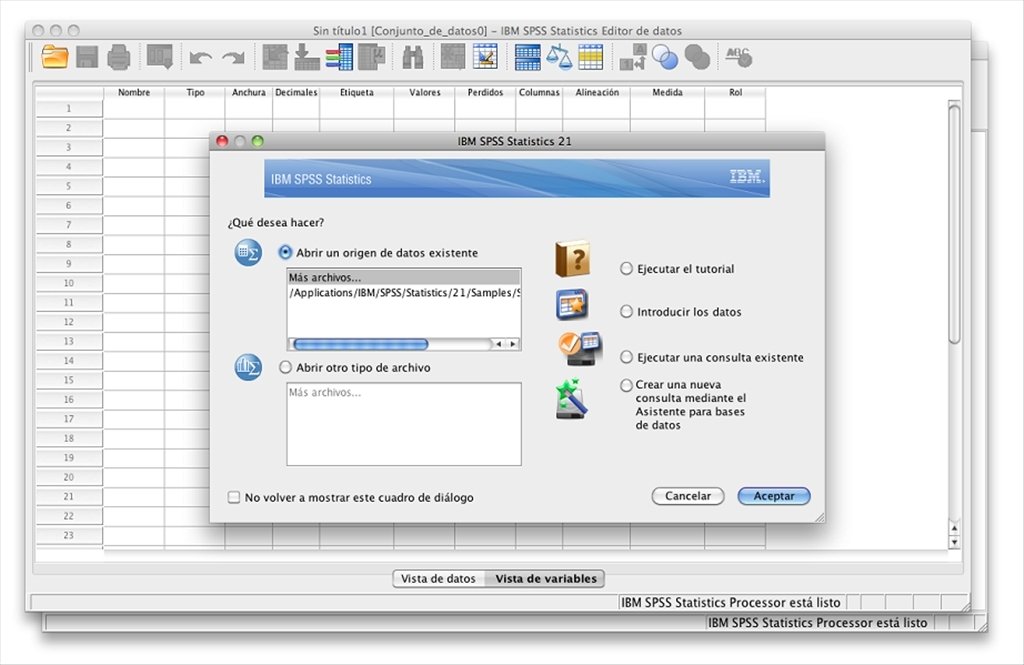

In this study, we aimed to identify the electro-clinical features in a cohort of patients due to FCDs. More reports further suggested that high-frequency oscillations (HFOs) occurring on SEEG were biomarkers of the epileptogenic zone (Kerber et al., 2013 Ferrari-Marinho et al., 2015).
#Ibm spss statistics for mac 10.9.5 windows
High-MRI resolution has improved the identification, and localization of some forms of FCD types, electrocorticography (ECoG), or stereoelectroencephalography (SEEG) provides invasive windows for understanding the intrinsic epileptogenicity of FCDs. The Magnetic resonance imaging (MRI) changes and electro-clinical features of FCD subtypes are variable. According to the International League Against Epilepsy (ILAE) classification, FCD is classified into three pathological subtypes. ( 1971) The exact cause of FCD is unclear, but cellular and/or architectural abnormalities such as irregular neurons and balloon cells during utero brain development or early postnatal injuries are closely related to FCD (Krsek et al., 2010).

Distinct IOPs may demonstrate different ripple features and distinguishing the IOPs is very necessary to have an insight into the electrophysiological characteristics.įocal cortical dysplasia (FCD) is one of the most common pathological substrates of refractory focal epilepsy. The clinical expression of seizure may depend on the pathological types with FCD II patients exhibiting their seizures at an earlier age.

Patients with subtypes III and II had favorable surgical outcome than those with I. The mean follow-up duration was 2.7 years (range 1–4.2), and 66.7% ( n = 40) were class I. Ripple density decreased between ictal onset and ictal evolution sections in patterns of LVFA and rhythmic spikes or spike waves ( p < .05). Regarding the distinct IOPs, ripple density continued to increase significantly between the interictal and ictal onset sections in LVFA, rhythmic spikes or spike waves, and burst of high-amplitude polyspikes ( p < .05). In addition, ripple density was found to increase significantly from the interictal to ictal onset sections and from the ictal onset to ictal evolution sections in patients with FCD I ( p < .001). In patients with temporal lobe epilepsy (TLE), the most common patterns were rhythmic spikes or spike waves and LFRS, and in patients with extratemporal epilepsy, the most common patterns were low-voltage fast activity (LVFA) and rhythmic spikes or spike waves. Six different ictal onset patterns (IOPs) were identified. Patients with type II tended to have their seizures at an earlier age than those with I and III ( p < .01). Sixty patients (31 FCD type I, 13 II, and 16 III) were analyzed retrospectively. The high-frequency oscillations (HFOs) features of SEEG, clinical characteristics, and surgical outcome were evaluated. We studied consecutive patients with drug-refractory epilepsy who underwent SEEG recording.
#Ibm spss statistics for mac 10.9.5 series
To evaluate the clinical and stereoelectroencephalography (SEEG) features and postsurgical outcome in a uniform series of patients who underwent epilepsy surgery and had pathologically confirmation of focal cortical dysplasia (FCD).


 0 kommentar(er)
0 kommentar(er)
